Chapter 5—
"Working in Light": Kenneth Anger
Never did eye see the sun unless it had first become sunlike.
—Plotinus, The Enneads
—from Rabbit's Moon
I see the lights! I see the party lights!
—Claudine Clark, sound track of Scorpio Rising
In the final moments of Brakhage's film Creation (1979), rays of prismatic color flash into the image from the top of the frame. It is sunlight falling through the high branches of a forest, striking the edge of the camera's lens and dispersing into a spectrum. That crystalline spray of light is Brakhage's homage to the source of creation in nature and cinema. Kenneth Anger honors the same source in the form of Lucifer, the angel whose name means "light-bringer." "Lucifer is the angel of light, a sunbeam," Anger has said. In Anger's personal hagiology Lucifer is also "the patron saint of movies, the light behind the lens."[1]
"I'm an artist working in Light, and that's my whole interest, really." Any number of avant-garde filmmakers might have said that, but only Kenneth Anger would add, "Lucifer is the Light God, not the devil, that's a Christian slander. The devil is always other people's gods. Lucifer has appeared in other of my films; I haven't labelled him as such but there's usually a figure or a moment in those films which is my 'Lucifer' mo-
ment."[2] Coming shortly after the release of Invocation of My Demon Brother (1969), those comments mark a significant change in Anger's way of "working in Light": from an implicit expression of light's visionary powers to an explicit illustration of a mythology of light, in which Lucifer is the reigning deity.
As interesting as Anger's presentation of Lucifer may be, it is his pre-Lucifer films that offer the best examples of his skill at manipulating light's movement in time. In these films the special power of light manifests itself directly, without the mediation of Lucifer or the signs, symbols, and rituals of his worship. They offer abundant evidence that long before Lucifer became the personification and visual correlative of light, Anger was aware of light's peculiarly powerful influence on perception and used it for what he would call "magickal" effects. I would prefer to call them moments of heightened perception when the viewer experiences light's power—power that does not depend upon Anger's personal mythology or the esoterica of Aleister Crowley and the occult traditions he espoused. Without doubting Anger's indebtedness to Crowley—evidence of which abounds in interviews, in Anger's notes on his films, and in the films themselves—it is still possible to argue that Anger's most "visionary" images of light are not for the initiated only.[3] They are for everyone whose eyes are open to the light of the films, and whose mind is open to the visionary traditions of art and religion that both East and West have harbored.
1—
At the heart of those traditions is what Aldous Huxley calls "preternatural light," by which he means a special luminosity of objects seen during a visionary experience. Huxley describes and explores the implications of preternatural light in Heaven and Hell , his sequel to the better-known Doors of Perception .[4] Whereas the latter concentrates on Huxley's own experiences under the influence of mescaline, Heaven and Hell transposes his personal experience to cultural and historical levels. Drawing his evidence from reports of experiments with sensory deprivation and hallucinogenic drugs, as well as from the testimony of seers, mystics, poets, and visual artists, Huxley makes a comparative study of visionary experiences and finds that such experiences have certain visual features in common. Since the same visual features appear in Anger's films, I propose to approach Anger's treatment of light by way of Huxley's account of the visionary experience.
"First and most important," Huxley writes, "is the experience of light. Everything seen by those who visit the mind's antipodes is brilliantly illuminated and seems to shine from within" (75). In the writings of visionaries, Huxley notes, this "preternatural light" is commonly expressed through references to gemstones, pearls, gold and silver, crystal and glass; in other words, to those materials in our normal, nonvisionary world that are most luminescent, most intensely glowing with color, and therefore most like the "self-luminous objects" seen by the visionary. As a characteristic example, Huxley quotes from the Hindu Ramayana : "The country all around is covered by jewels and precious stones, with gay beds of blue lotus, golden-petalled. Instead of sand, pearls, gems, and gold form the banks of the rivers, which are overhung with trees of fire-bright gold" (83). A Biblical counterpart to this vision of the Other World is found in the Book of Ezekiel: "Thou has been in Eden, the garden of God. Every precious stone was thy covering, the sardius, topaz and the diamond, the beryl, the onyx and the jasper, the sapphire, the emerald and the carbuncle, and gold. . . . Thou hast walked up and down in the midst of the stones of fire" (84). On the evidence of passages such as these Huxley concludes that "precious stones are precious because they bear a faint resemblance to the glowing marvels seen with the inner eye of the visionary" (86).
Furthermore, Huxley argues, "Whatever, in nature or in a work of art, resembles one of those intensely significant, inwardly glowing objects encountered at the mind's antipodes, is capable of inducing, if only in a partial and attenuated form, the visionary experience" (87). Hence the gleaming altars and glowing stained-glass windows in the cavernous gloom of medieval cathedrals; hence the gold and silver, the bejewelled and pearl-encrusted art and artifacts at shrines throughout the world. "Polished metals and precious stones are so intrinsically transporting," says Huxley, "that even a Victorian, even an Art Nouveau jewel is a thing of power. And when to this natural magic of glinting metal and self-luminous stone is added the other magic of noble forms and colours artfully blended, we find ourselves in the presence of a genuine talisman" (88).
Kenneth Anger, who once remarked that filmmaking "is like making a painting out of real gold and jewels," creates cinematic equivalents of the "talismans" Huxley so eloquently describes.[5] The basis of that equivalence is light: light with the gemlike intensity of a visionary experience.
Anger's most literal association of light with the vision-inducing power of precious stones and metals appears in the opening sequence of Inauguration of the Pleasure Dome (1954, revised 1960, 1966, 1978). From a
glowing horizon, soft beads of light climb slowly upward. Then, as the focus sharpens, the lights are revealed to be a string of diamondlike gems rising from the floor to a bed. Supine on the bed, Lord Shiva (as Anger identifies his protagonist) slowly wraps the string of gems around his hand. After langorously selecting several sumptuous rings from his bedside table and slipping them on his fingers, he lowers the dangling gems into his mouth and swallows them.
This strange opening is echoed three times in the film. Lord Shiva subsequently swallows a large crystal pendant, a pearl, and a gold-link snake—gifts ceremoniously presented to him by his guests. In his description of the film, Anger identified each gift as a "talisman," which calls to mind Huxley's description of a Victorian or Art Nouveau jewel as a "genuine talisman." For Anger, as for Huxley, the source of this talismanic power is light. The softly focused opening of Inauguration of the Pleasure Dome makes the gems look like a string of small lights. By sharpening the focus as the shot continues, Anger cinematically transforms the lights into precious stones. Although he hardly belabors the point, Anger has opened his film by demonstrating the source of the gem's potency (in terms that Huxley's discussion makes even clearer) and has provided a clue to the symbolic significance of swallowing the string of gems, the crystal pendant, the pearl, and the gold snake. In material forms resembling the "self-luminous objects" of the visionary experience, Lord Shiva is ritually ingesting light itself.
These rituals suggest a Eucharistic ceremony, and in a headnote to one of his descriptions of the film, Anger quotes Aleister Crowley:
A Eucharist of some sort should most assuredly be consumed daily by every magician, and he should regard it as the main sustenance of his magical life. It is of more importance than any other magical ceremony, because it is a complete circle. The whole of the force expended is completely re-absorbed; yet the virtue is that vast gain represented by the abyss between Man and God. The magician becomes filled with God, fed upon God, intoxicated with God. Little by little his body will become purified by the internal lustration of God.[6]
Through this association of the jewels with the Eucharist, Anger implies that it is not enough to possess and contemplate these "talismans" of light. They must be consumed if their vision-inducing power is to be realized. Then Lord Shiva may be "purified by the internal lustration of God."[7]
Anger intended the film as a whole to have a comparable Eucharistic effect on the audience. In an interview published in 1967 he describes his
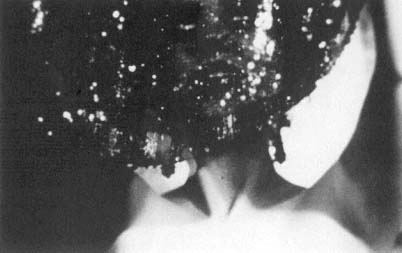
Donning a sequined black dress in Puce Moment .
goal: "[I] wanted to create a feeling of being carried into a world of wonder. And the use of color and phantasy is progressive; in other words, it expands, it becomes completely subjective—like when people take communion; and one sees it through their eyes."[8] The effect is "progressive" in the sense that the frenetic rhythms and multiple superimpositions of the film's hallucinatory climax represent the cumulative "subjective" effect of the lush colors; the exotic costumes; the Beardsleyesque jewelry, draperies, and candles; and the somnolent movements and ritualized gestures of the hieratic characters in the first two-thirds of the film.
If Lord Shiva's ingestion of gems suggest that preternatural light may be taken internally, so to speak, then there is evidence in other films that it may be administered externally as well. It may be put on the body and worn, like the rings Lord Shiva puts on before swallowing the string of gems or the three large silver rings the protagonist of Scorpio Rising (1963) chooses for himself before going to the motorcyclists' party. Other motorcyclists cover themselves with vision-inducing ornaments, as Anger memorably records in the "Blue Velvet" sequence of Scorpio Rising —a sequence that may be more fully appreciated if we first examine the dressing scene in Anger's early film fragment Puce Moment (1949).
That film begins with a parade of elaborately sequined dresses. As each dress is held up to the camera, it passes in and out of focus, and as it does so its sequins turn into dancing dots of light against colored backgrounds.
The effect is most striking when the last dress appears: a black gown whose sequins flicker and gleam like a myriad of stars in a black sky. This is the dress the film's heroine puts on. She raises her arms above her head and laughs ecstatically as the dress descends, enveloping her in a sheath of glittering lights. To don the dress is to enjoy a "transporting" experience—as the pop songs on the sound track clearly announce: "My mind will listen to the stars . . . my mind is in the air," and, "Yes, I am a hermit, my mind is not the same. Yes, I am a hermit, and ecstasy is my game." Parts of Puce Moment appear in the superimposed material at the climax of Inauguration of the Pleasure Dome , which further suggests that the dresses are "talismans" of "preternatural light."
In Scorpio Rising the clothes of the motorcyclists take on a similarly visionary significance. Against black leather and blue jeans, the silver studs, chains, buckles, amulets, and trinkets shine with exceptional brilliance, and in some shots they flash their reflected light directly into the eyes of the audience. During this "dressing adagio," as Anger has called it,[9] camera movement and montage supported by Bobby Vinton's sinuous rendition of "Blue Velvet" meld the slow, studied gestures of the men into a continuous flow. The result is a mood that rises above mere sensuality and self-indulgence. It suggests reverence for these light-bearing garments.
The same mood and movement accompanies Anger's presentation of the objects most radiant with "the natural magic of glinting metal": the motorcycles themselves. A chain becomes linked lights in velvety darkness. The rounded edge of a gas tank reflects brilliant rays of light. The bars, tubes, and cylinders of polished chrome gleam like intricate jewelry. In the nighttime streets, the motorcycles not only glitter with reflected light but shine their headlights directly into the camera and, therefore, into the viewer's eyes.
"I see the lights! I see the party lights!" sings Claudine Clark as Anger introduces a close-up of a motorcycle's front wheel with blinking lights entwined in its spokes. Decorated like a sacred effigy, the motorcycle presides over the rowdy gathering that Anger calls a "cycler's Sabbath" and a "Walpurgis Party."[10] It is also—though the participants may not be conscious of it—a celebration of the motorcycle as a "light-bringer." Appropriately, "I see the lights!" resonates with religious and mystical implications. Anger is a master at evoking unexpected meanings from the seemingly banal lyrics of popular songs, and in this case he implies that those watching the film should be able to "see the lights" as well. In fact, the audience has been seeing them since the film began. Throughout
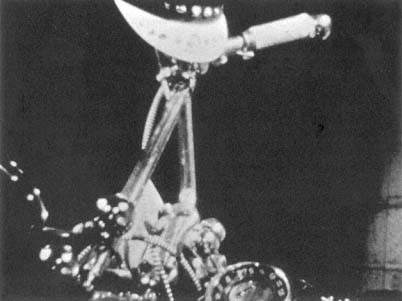
The motorcycle as talisman in Scorpio Rising .
Scorpio Rising , the motorcycle is shown to be a "genuine talisman" and "a thing of power," not because of its size, noise, or horsepower, nor because of its popular association with speed, gangs, and violence, but because of the gleaming luster with which it hints at "the glowing marvels seen with the inner eye of the visionary."
If Scorpio Rising hints at the supernatural power in gleaming metal, Kustom Kar Kommandos (1964) dwells on it. If preternatural light is glimpsed against the darkness of deep-shadowed garages, black leather, and night in Scorpio Rising , it boldly and steadily shines forth in Kustom Kar Kommandos . If parts of the motorcycles are sometimes jewel-like, the customized car is itself a single, complete jewel. It is placed on display in a clean, well-lighted room and attended by a blond young man in pristine blue who worshipfully dusts it with a feathery white puff. Then he climbs inside, encasing himself in an interior of polished chrome and red leather seats. While the whispery voices of the Parris Sisters sing about a "dream lover" and their longing to "know the magic of his charms," Anger's gliding camera movements and smoothly articulated montage turn the car's polished surfaces into silvery streams of light, leaving no doubt that the car is a "dream lover" and a magical "charm."
In Heaven and Hell Huxley complains that modern technology, advertising, and the mass distribution of manufactured goods have made intense light, gleaming surfaces, and brilliant colors so commonplace that they have lost their visionary power. Our sensibilities have been dulled by the omnipresence of glass, chrome, stainless steel: "Metal surfaces wink at us in the bathroom, shine from the kitchen sink, go glittering across the country in cars and trains. . . . What was once a needle of visionary delight has now become a piece of disregarded linoleum." (95) But Anger understands that even the products of modern technology can be transformed into vessels of preternatural light. By carefully capturing their brilliant flashes of reflected light, Anger turns them into visual equivalents of precious stones and metals. Then, to make the "precious" become "preternatural," he gives the light a life of its own, and while the viewer's attention is drawn to the sensuous beauty of sequined dresses, studded black leather, and chromium motor parts, the light they emit reaches "the antipodes of the mind," in Huxley's phrase, where all experience is visionary.
The work that most completely exemplifies this process is Eaux d'artifice (1953). Here water is the principal medium for preternatural light, and a "Water Witch" (Anger's designation) is its personification. The film's blue tinting turns every shadowed area into a rich, dark blue "setting" for the gemlike light reflecting off the water and the sequins in the Water Witch's gown. In effect, the tinting turns the strip of film into a blue stream from (or through) whose surface preternatural light gleams and flashes into viewers' eyes as they follow the mysterious bright figure who emerges from the plumed jet of a fountain at the beginning of the film, journeys through the glittering garden, and returns to the down-flowing watery light at the end. Anger's editing reinforces the water-light metaphor by joining most of the shots with dissolves that carry one image into the next like water flowing over shiny stones.
"Pour water on thyself: thus shalt thou be a Fountain to the Universe. Find thou thyself in every Star! Achieve thou every possibility!" Taken from the writings of Crowley, that is the epigraph for Anger's notes on Eaux d'artifice .[11] The film pours light on its viewers, so that they may find a "Star" in themselves. The visionary quality of light in the film is nicely captured in the Homeric term "splendor," which, as Michael Bernstein points out, "is one of the standard Homeric epithets appropriate to water, especially when the reference is to a scared fountain or temple district." As an example Bernstein quotes from the Iliad (II, 307): "whence did flow splendid water."[12]
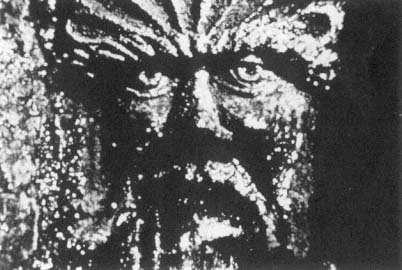
"Splendid water" glazes a stone face in Eaux d'Artifice .
Although the brief flash of chartreuse light emitted by the Water Witch's fan might seem to be the "Lucifer moment" of the film, I would argue that there are many and more splendid moments provided by the water itself. Fountains, pools, streams, and falls glitter in the deep blue shadows of the garden, and even stone steps and carved faces gleam as the "splendid water" glazes them with liquified light. In one particularly elegant sequence, slow motion transforms thin sprays of water into streaks and beads of light that glitter like gems strung across the deep blue darkness. It is a triple transformation: from water to light to gems. These gems could, indeed, be swallowed by Lord Shiva, but they are consumed by the viewer's eyes instead.
Similar images appear in close-ups of the motorcycles in Scorpio Rising , the customized car in Kustom Kar Kommandos , and the black-sequined dress in Puce Moment . The flow of light in Scorpio Rising and Kustom Kar Kommandos follows the intricate structure of mechanical parts. In Eaux d'artifice and Puce Moment the light is less tightly patterned, but in every case the flickers and gleams shine out against a blue-black background—not like immaterial, abstract designs, but like patterns of energy shimmering with a peculiar, mercurial solidity. They are the purest and most autonomous expressions of preternatural light in Anger's films.
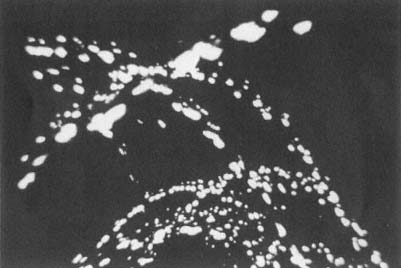
Slow motion transforms a fountain's spray into
beads and streaks of light in Eaux d'artifice .
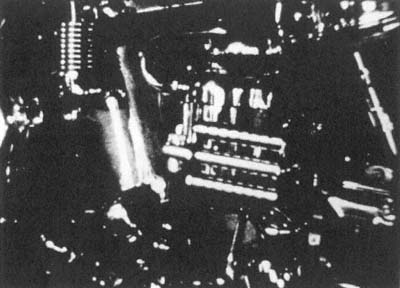
A motorcycle glows in the dark in Scorpio Rising .
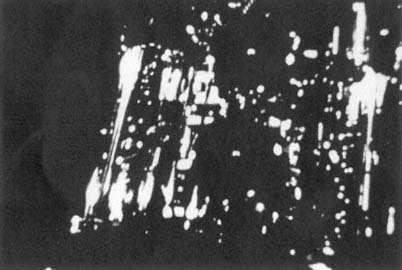
Preternatural light gleams from the polished
engine of a customized car in Kustom Kar Kommandos .
2—
Anger's images of preternatural light are not there simply for visionary delight. They also support a major and recurrent theme of Anger's work: the deep yearning to unite with the light, to swallow it, wear it, ride on it, or enter and become one with it. To demonstrate the pervasiveness of this theme in Anger's work, it will be necessary to examine some films in which Anger's thematic concern with light is not always translated into images that work so directly on the viewer's perception. Two such films—Fireworks and Rabbit's Moon —dramatize light's potency and magnetic attraction without emphasizing preternatural light at the most immediate level of perception.
In Rabbit's Moon (shot in 1950, released in 1971, revised in 1980), Pierrot repeatedly and fruitlessly grasps at his source of light, the moon. "The moon is his mama and woman and illusion ill met by moonlight," Anger writes in an informal synopsis-analysis of his film.[13] But there is another source of light in the film: a magic lantern, which Anger identifies as "my art."[14] The magic lantern produces three cabalistic drawings: a star, a crescent moon, and the sun with an eye in its center (of which more will be said later). It also produces—or reveals—the lovely Columbine, who proves to be just as unattainable as the moon. She rejects Pierrot in
favor of Harlequin, and the film ends with Columbine in Harlequin's arms, while Pierrot's body plummets to the ground as if flung down by the moon it/herself.
The sugary pop songs on the soundtrack reinforce (as they simultaneously mock) Pierrot's longing. "There's a thrill in my heart I never felt before. O, darling, where have you been?" accompanies Pierrot as he reaches toward the moon and as a drawing of the moon seems to draw nearer through a series of zoom-dissolves. Since the film is set in a moonlit woods (an effect enhanced by the film's blue tinting), Pierrot's longing for the moon is equivalent to longing for the source of light itself. As Marjorie Keller perspicaciously observes, "The light is the object of desire, the source of all energy (the sun), its reflected principle (the moon) and its earthly manifestation (the magic lantern, the projector)."[15] The new sound track of the more recent, shorter version of the film makes the same point succinctly if ironically: "Give him a light" is sung as Pierrot looks longingly at the moon.[16]
In Fireworks (1947) the protagonist, played by Anger himself, also "goes out in the night seeking 'a light,'" as Anger writes in a program note for the film.[17] The phrase carries sexual connotations, which are reinforced by the film's overt treatment of homosexual longing and (temporary) fulfilment. But there are other and more interesting connotations as well. Unlike Pierrot, the protagonist of Fireworks succeeds in his search for "a light." First he gets a light for his cigarette from a muscular sailor whose match is a flaming bundle of sticks. (That image is echoed in Inauguration of the Pleasure Dome when the Great Beast magically produces a flame in his hand and uses it to light the cigarette of the Scarlet Woman, and in Scorpio Rising when separate shots of Scorpio and Marlon Brando are intercut to suggest that in lighting their own cigarettes they are also lighting each other's.) Then, the protagonist finds—or, more precisely, is found by—a sailor-lover whose penis is a Roman candle ejaculating sparks and balls of fire. The protagonist's response is to enter wearing a sparkling Christmas tree on his head. A flaming candle tops the tree. At the end, as the lover lies in bed, a corolla of light (scratched by Anger into the film's emulsion) surrounds his head. From head and loins comes evidence that this is, indeed, the bearer of light sought by the protagonist.
The handmade corolla suggests that this may be one of the "Lucifer moments" Anger incorporated into his earlier films. Many years later Anger told Jonas Mekas, "The last shot in 'Fireworks' is me in bed, and there is another boy in bed but his face is all bursting with white flames, or
light. This is the Lucifer brother, you see, the Unknown Angel side. In my own drama as an artist, I am always looking for him, that angel side."[18]
In the image of a "Lucifer brother"—and lover—the sexual and the visionary themes of the film combine and reinforce each other. It is a mutual reinforcement with many precedents in the history of magic, mysticism, and the more esoteric practices of some religions—from the Eleusinian mysteries of ancient Greece, to tantric yoga, to the sexual magic of Aleister Crowley. To pursue the sexual aspects of the visionary tradition—as Huxley pursued its visual aspects—would take us far beyond the intentions of this chapter, but one specific detail is directly relevant to Fireworks in particular and the light-motif of Anger's work in general. In The Doctrine of the Subtle Body , the great scholar of mystery religions G.R.S. Mead writes:
Hidden in the seed of the tree is the principle (ratio, logos ) of the tree. This is the formative power (virtus, dynamis ) in the seed, the spermatic principle, which is called symbolically in Greek spintherismos . . . [which] means, literally, "emission of sparks," "sparking." "Light-spark," or "light-emanation" . . . is used by a number of Gnostic schools as a symbolic expression for the "germ" of the spiritual man.[19]
The seventeen-year-old who made Fireworks may not have known about the esoteric doctrines Mead writes of, but he seems to have had an intuitive grasp on the mystical equation of the "spermatic principle" and "light-emanation."
The sexual-visionary theme of Fireworks first appears in the overheated prose of a prologue spoken by Anger:
In Fireworks I released all the explosive pyrotechnics of a dream. Inflammable desires dampened by day under the cold water of consciousness are ignited at night by the libertarian matches of sleep, and burst forth in showers of shimmering incandescence. These imaginary displays provide a temporary relief.
Anger later replaced the spoken prologue with a flash of lightning. Perhaps that was his way of balancing the weight more evenly between the visionary and sexual implications of his search for "a light." Since the revised version opens the collection of his works called "Magick Lantern Cycle," that flash of lightning suitably announces the visionary theme of Anger's work as a whole.
It is a theme expressed through the ecstasy of donning a shining black dress in Puce Moment and in the consumption of gems in Inauguration of the Pleasure Dome . It underlies the more sinister mixture of preternatural light and the death wish in Scorpio Rising and the young man's surrender
to his gleaming "dream lover" in Kustom Kar Kommandos . It also motivates the invocations of Lucifer in Anger's most recent films.
By the time he made Invocation of My Demon Brother , Anger's "light" had become explicitly the Light, Lucifer, and the theme of yearning to unite with the light had become the worship of the "light-bringer" himself. Although Anger says that the angel invoked in Invocation of My Demon Brother is "the Dark One," the conclusion of the film suggests otherwise.[20] Instead of going out in the night to find an incandescent sailor to be his "Lucifer brother," Anger performs a magical ceremony to invoke a smiling Lucifer with moirélike patterns of light playing over his naked torso. One notes, however, that Anger's manic expressions and frantic movements (produced by an undercranked camera) convey none of that serene sense of fulfilment that accompanies the images of preternatural light in the pre-Lucifer films. Moreover, the light is not preternaturally intense. Like the Roman candle and scratched-in corolla of light in Fireworks , it symbolizes Lucifer's light-bearing nature but does not express it as directly as the sequined gown of Puce Moment , the polished metal of Scorpio Rising and Kustom Kar Kommandos , and preeminently the water of Eaux d'artifice . It is more conceptual than perceptual.
There are only two instances of preternatural light in Invocation of My Demon Brother . A procession is led down a staircase by a woman wearing a hooded red robe and carrying a wand tipped with a large, clear jewel. Possibly she is the "Scarlet Woman" of a Crowley-inspired ceremony (see note 7). As she turns and passes offscreen, the gem emits a brilliant blue-white flash of reflected light. The flash is reminiscent of the sudden gleam of chartreuse light from the Water Witch's fan in Eaux d'artifice , but it is more intense and gemlike. Preternatural light also emanates from Anger himself as he performs his magical ceremony under spotlights on a darkened stage. Light reflects brilliantly off the glitter on his face and the sequins of his robe, and as he reaches the climax of his ceremony, superimposed rays of light stream from his forehead.
To invoke the Light, one must become like it. Becoming like it, one may unite with it. That seems to be the Neoplatonic message of the film. "Never did eye see the sun unless it had first become sunlike," to repeat the quotation from Plotinus at the head of this chapter.[21] The same message is symbolized in the diagram of the eye in the sun that Anger includes in Rabbit's Moon . That sun-eye, rather than the more familiar Eye of Horus (which appears in Invocation of My Demon Brother and Inauguration of the Pleasure Dome ), would seem to express most precisely Anger's sense of the ultimate possibilities of visual perception.
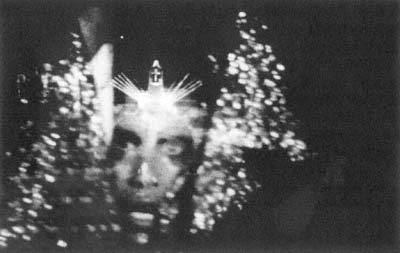
Light shines from the forehead of Kenneth Anger as
the magus in Invocation of My Demon Brother .
While working on Lucifer Rising (1966–80), Anger said, "I am trying to find the angel again, the Angel of Light."[22] But in finding Lucifer, Anger seems to have lost preternatural light. Although several sequences take place at "sites of sun worship," they do not reveal "the Light" directly.[23] Instead, an eclectic collection of deities and priests invoke and worship "the Angel of Light," who materializes in the thoroughly mortal form of a young man with "LUCIFER" and the seven colors of the spectrum decorating the back of his satin robe. Only one gem is presented with visionary intensity. Extreme close-ups of a deep red ruby are intercut with a ceremony of blood sacrifice, for which the inspiration would seem to be two lines from Aleister Crowley's "Hymn to Lucifer": "His body a blood-ruby radiant/With noble passion, sun-soul'd Lucifer."[24] But the closest approximation to the preternatural light of the pre-Lucifer films comes in brief reflections of sunlight on golden staffs that Isis and Osiris repreatedly raise in a ritual gesture that brings forth flashes of lightning. Despite its symbolic and visual richness, Lucifer Rising is less concerned with revealing light than with constructing an allegory of light, which stands between the viewer's eyes and light's preternatural powers.
At the other extreme is Eaux d'artifice , with its direct revelation of preternatural light and its triumphant fulfilment of the yearning to become one with the light. As the figure merges with the light, so the
viewer's perception may undergo a similar union between personal vision and preternatural light. Huxley suggests that contemplating the "glinting metal and self-luminous stone" of a beautiful jewel can transport us "towards the Other World of Vision." Perhaps contemplation of Anger's cinematic jewels can lead in the same visionary direction. At the very least, these cinematic manipulations of light are more convincing evidence of Anger's much-vaunted skills as a "magician" than are his displays of magical symbols, ritual invocations of Lucifer, and ominous references to film as a "magick weapon" for "capturing people" and "casting a spell."[25]
How susceptible one may be to Anger's "talismans" and how far one may be induced to go into "Other Worlds of Vision" depend on each viewer's susceptibility and willingness to follow Anger's lead. But even a viewer unsympathetic to visionary aspirations should find the concept of preternatural light useful in understanding Anger's work. It helps to explain the interconnected meaning of images that range from jewels, to objects that seem jewel-like in the intensity of their reflected light, to images of "pure" light. It connects those images to the visionary theme of Anger's work as a whole and helps to explain how he has been able to break through the invisible wall of the film medium and communicate directly with the minds of his audience. It specifies the particular juncture of light and visual perception that most unequivocally demonstrates Anger's skill as "an artist working in light."
